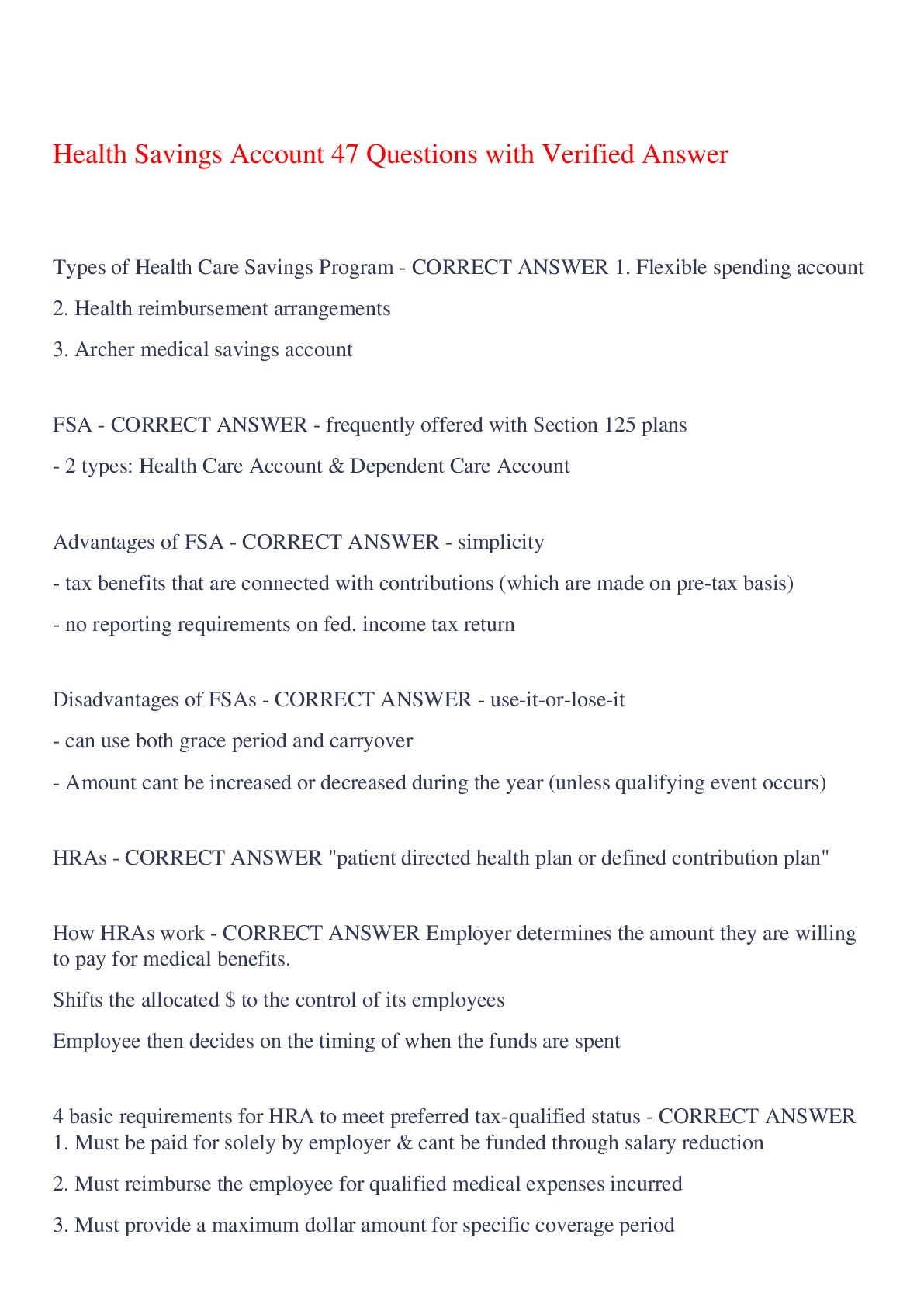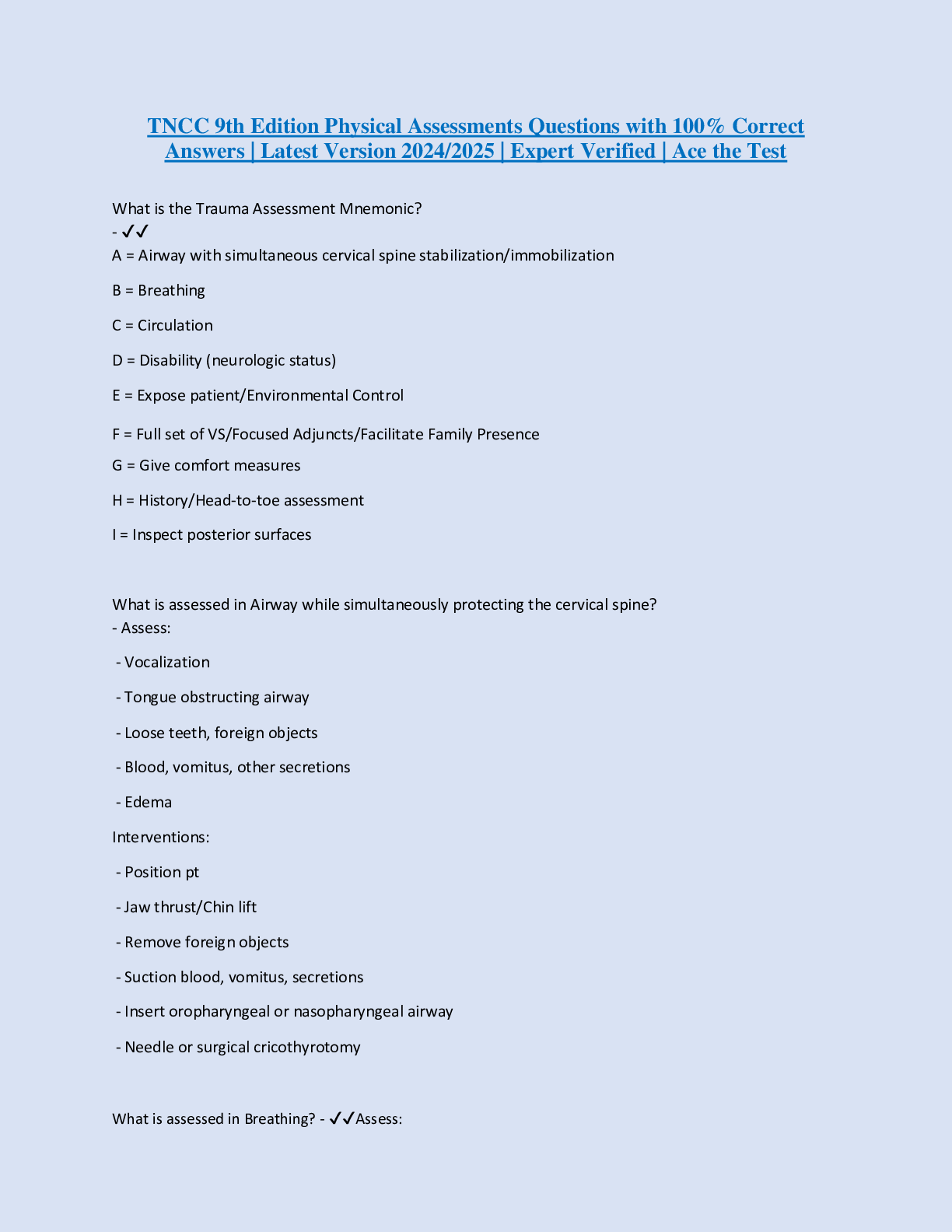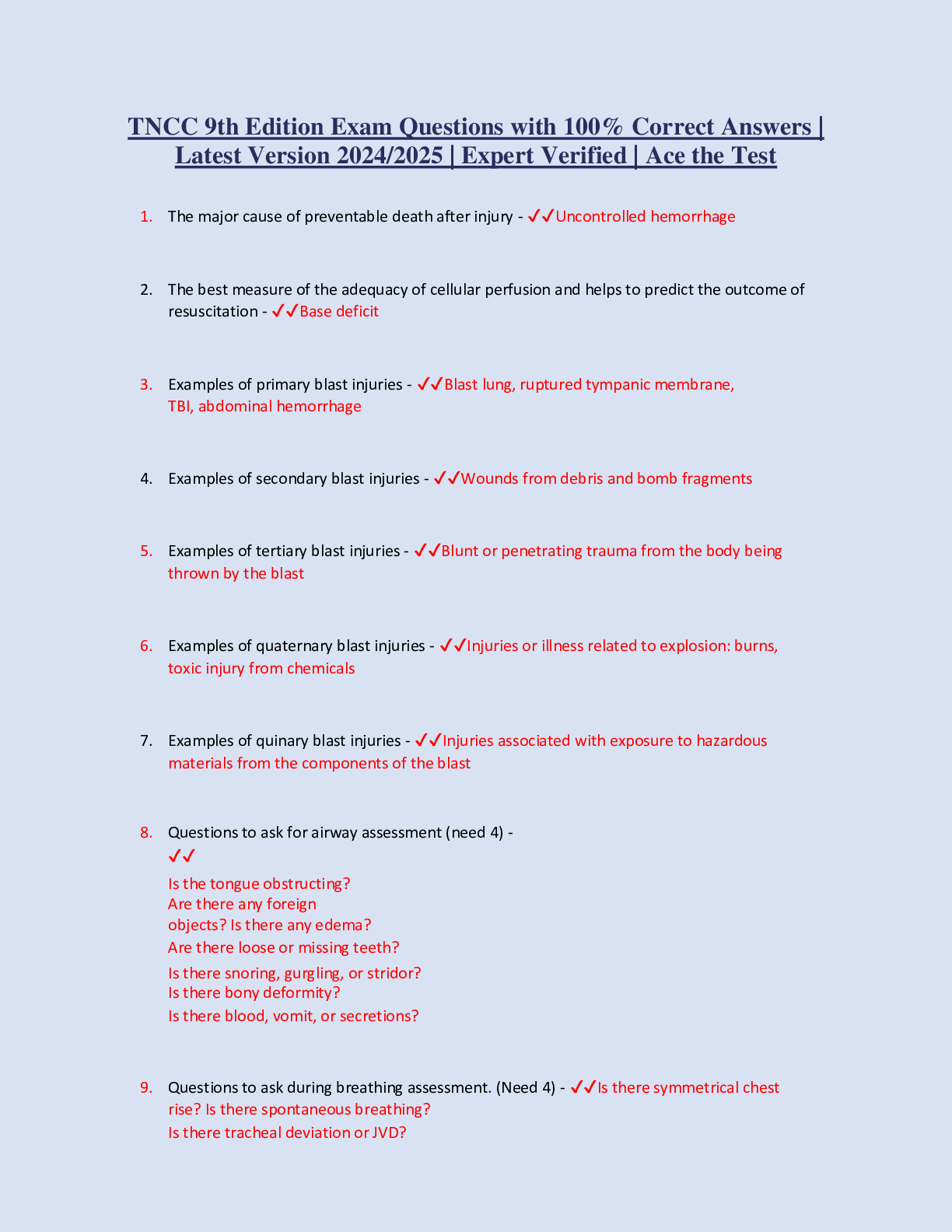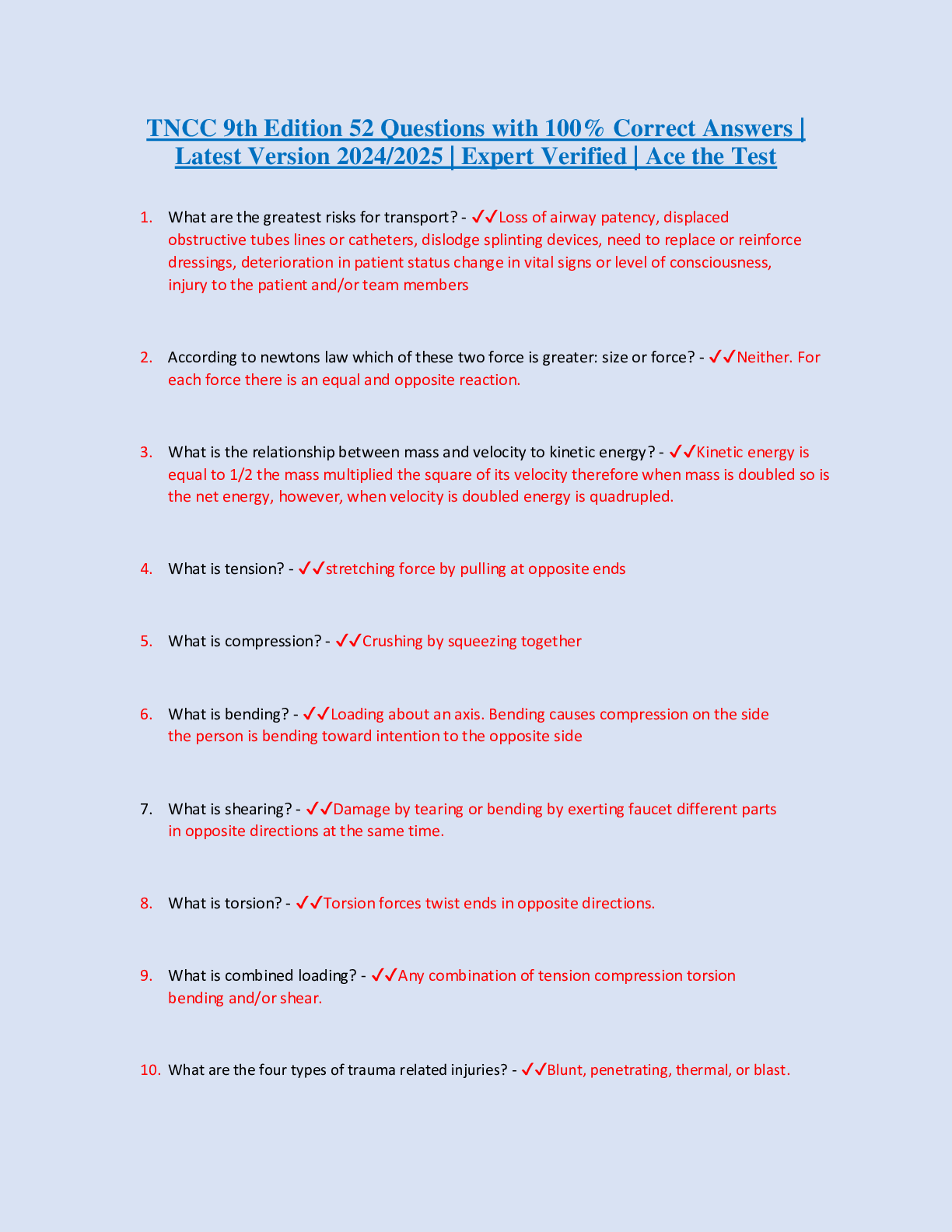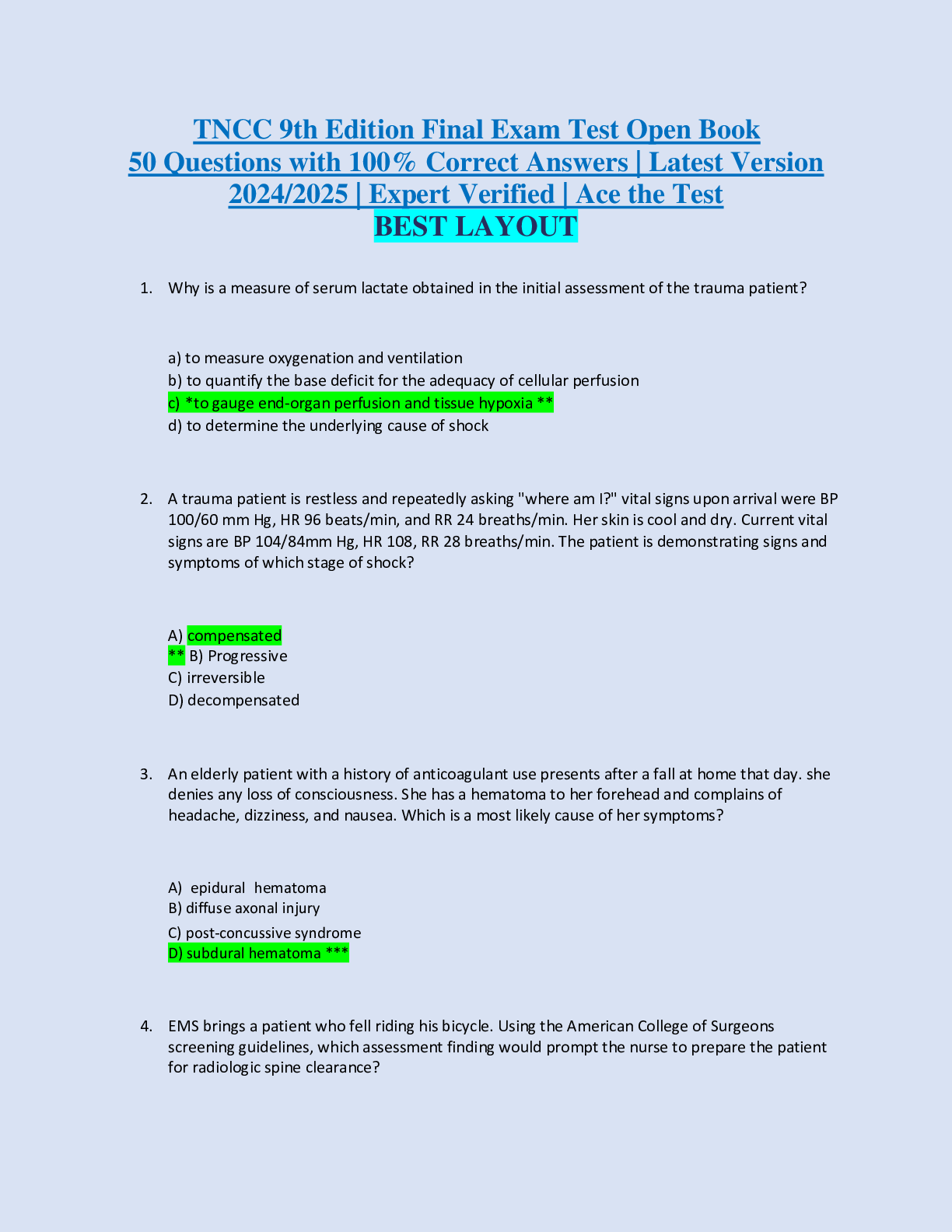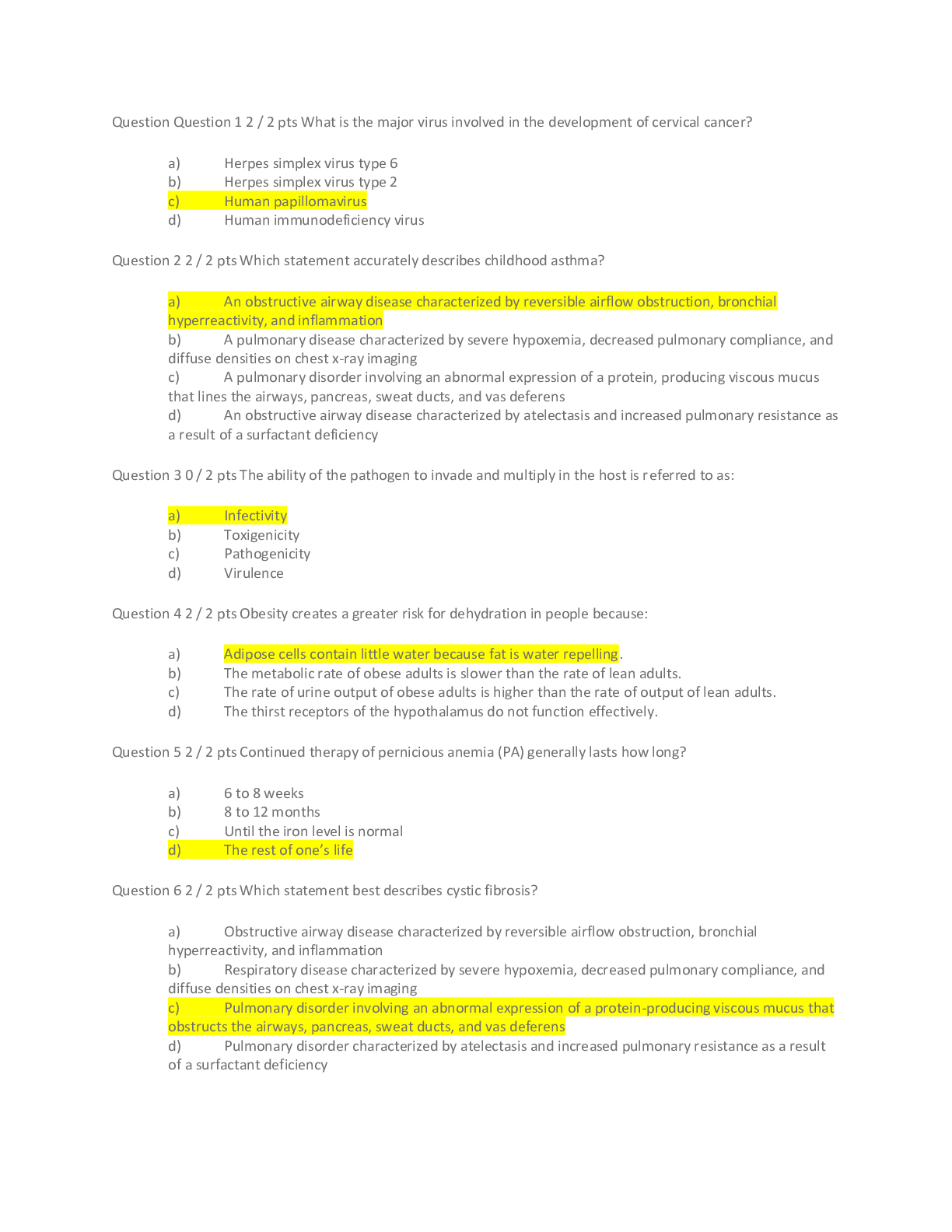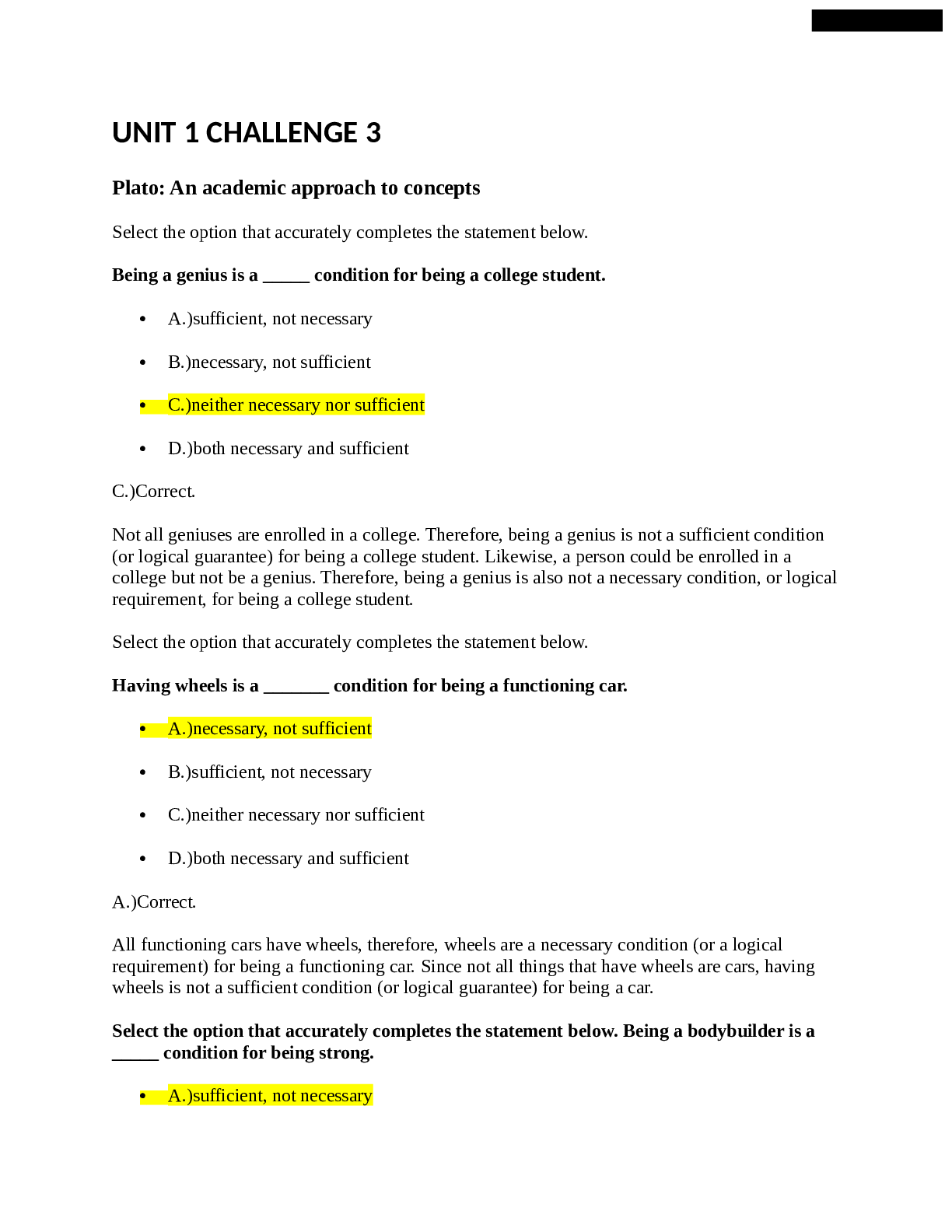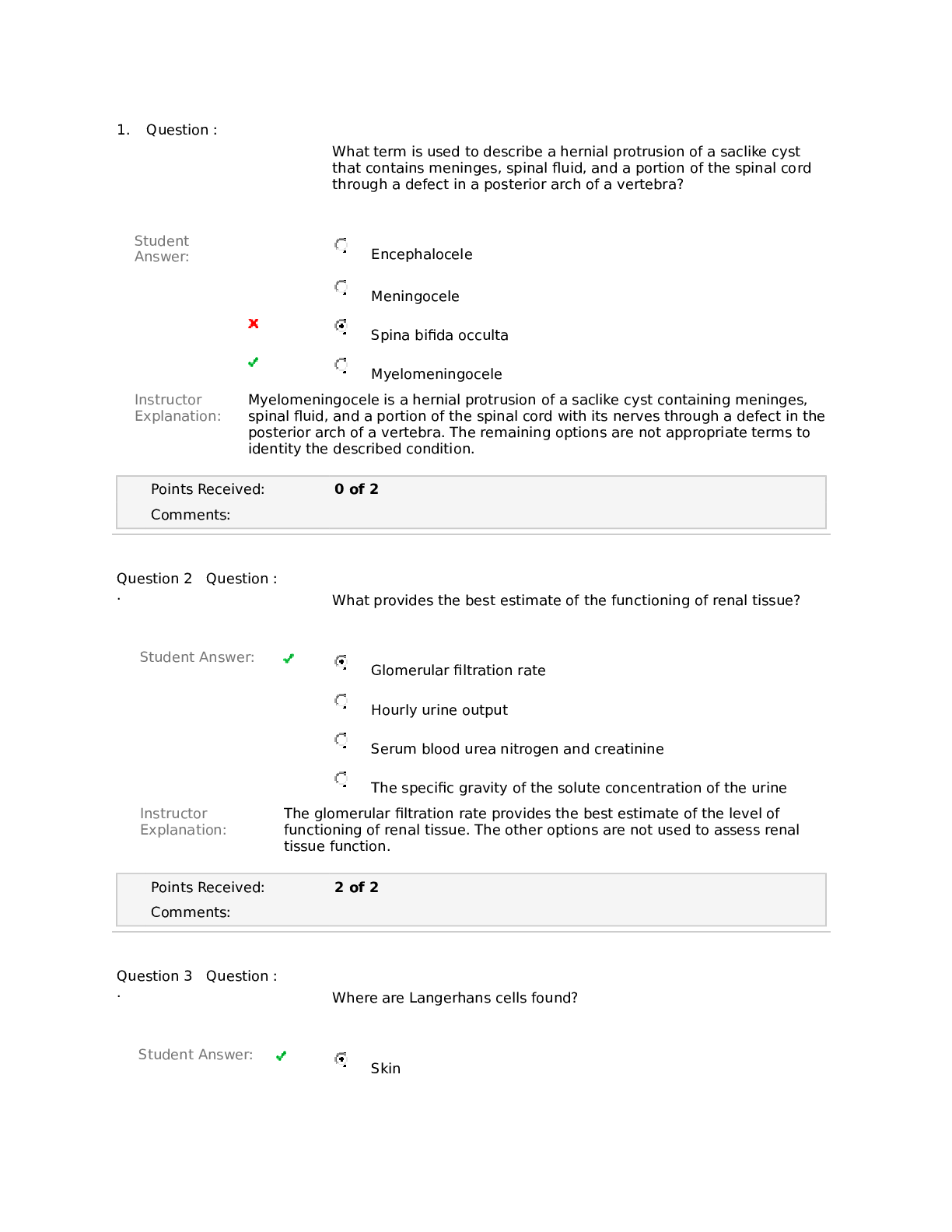*NURSING > EXAM > NURS 212: Percutaneous Administration Willihnganz: Clayton’s Basic Pharmacology for Nurses, 18th E (All)
NURS 212: Percutaneous Administration Willihnganz: Clayton’s Basic Pharmacology for Nurses, 18th Edition
Document Content and Description Below
NURS 212: Percutaneous Administration Willihnganz: Clayton’s Basic Pharmacology for Nurses, 18th Edition MULTIPLE CHOICE 1. A patient has an infected wound with large amounts of drainage. W... hich type of dressing would the nurse use? a. Telfa b. OpSite c. DuoDerm d. AlgiDERM ANS: D AlgiDERM is manufactured from seaweed and is recommended for infected wounds because it is an exudate absorber. Telfa and OpSite do not absorb exudates. DuoDerm is for light to moderate wound drainage. According to the manufacturer, it does absorb exudates, but it is best for wounds with moderate drainage. DIF: Cognitive Level: Comprehension REF: p. 83 OBJ: 1 NAT: NCLEX Client Needs Category: Physiological Integrity TOP: Nursing Process Step: Implementation CON: Clinical Judgment | Tissue Integrity | Infection 2. Where would the nurse apply nitroglycerin ointment on a male patient? a. The same site that was previously used b. A hairy area of the chest c. The upper arm d. The back of the knee ANS: C Any area without hair may be used. Most people prefer the chest, flank, or upper arm areas. Sites should be rotated. The back of the knee is not suitable for applying medication because of the joint motion and difficulty of keeping a dressing in place. DIF: Cognitive Level: Comprehension REF: p. 86 OBJ: 3 NAT: NCLEX Client Needs Category: Physiological Integrity TOP: Nursing Process Step: Implementation CON: Clinical Judgment | Safety 3. Where will the nurse administer a medication that was ordered to be given sublingually? a. Between the molar teeth and cheek b. Below the skin surface c. Under the tongue d. Into the conjunctival sac ANS: C The sublingual area is underneath the tongue. Between the molar teeth and cheek is the buccal area. Medication administered below the skin surface is intradermal administration. The conjunctival sac is between the eyelids and eyeball. DIF: Cognitive Level: Knowledge REF: p. 89 OBJ: 5 NAT: NCLEX Client Needs Category: Physiological Integrity TOP: Nursing Process Step: Implementation CON: Clinical Judgment | Safety 4. Why are sublingual and buccal medications rapidly absorbed? a. Their action is localized to the mouth. b. They are metabolized in the liver. c. Blood flow is diminished in these sites. d. These drugs pass directly into systemic circulation. ANS: D Sublingual medications are rapidly absorbed into systemic circulation because of the increased blood flow to these areas and avoid the “first pass” effect of the liver where extensive metabolism usually takes place. These routes do not contain drug effects to the oral area and they bypass the liver. These sites are highly vascular. DIF: Cognitive Level: Comprehension REF: p. 89 OBJ: 5 NAT: NCLEX Client Needs Category: Physiological Integrity TOP: Nursing Process Step: Assessment CON: Clinical Judgment | Safety 5. Which medications must be sterile? a. Topical b. Vaginal c. Ophthalmic d. Nasal ANS: C Ophthalmic (eye) medications must be sterile. Topical, vaginal, and nasal applications do not need to be sterile. DIF: Cognitive Level: Knowledge REF: p. 90 OBJ: N/A NAT: NCLEX Client Needs Category: Physiological Integrity TOP: Nursing Process Step: Implementation CON: Clinical Judgment | Safety 6. Which action will the nurse perform when doing a wet to dry dressing every 4 hours on a patient with a deep wound? a. Pack the wound tightly with gauze. b. Saturate the dressing with as much liquid as possible. c. Use Montgomery tapes or a binder to secure the dressing. d. Apply the new moist dressing over the existing one. ANS: C The use of Montgomery tapes or a binder reduces the irritation of nearby skin tissue. The dressing should be packed into the wound loosely. The dressings should be wrung out to prevent dripping. The previous dressing should always be completely removed. DIF: Cognitive Level: Application REF: p. 84 OBJ: 1 NAT: NCLEX Client Needs Category: Physiological Integrity TOP: Nursing Process Step: Implementation CON: Clinical Judgment | Safety 7. When applying nitroglycerin topically, which nursing intervention is correct? a. Secure the paper on two sides with tape. b. Shave the area prior to application of the paper. c. Wear gloves while placing the new paper. d. Remind the patient to discontinue use of the medication if chest pain is relieved. ANS: C Wearing gloves prevents accidental exposure to the medication. The area where the paper is placed should be covered with plastic wrap and taped into place to prevent medication from seeping out. Shaving may cause skin irritation. The dosage and frequency of application should be gradually reduced over 4 to 6 weeks, and the patient should contact the healthcare provider if adjustment is desired. DIF: Cognitive Level: Application REF: p. 86 | p. 87 OBJ: 3 NAT: NCLEX Client Needs Category: Physiological Integrity TOP: Nursing Process Step: Implementation CON: Clinical Judgment | Safety 8. Where does the nurse correctly administer ophthalmic medication? a. At the inner canthus of the eye b. In the lower conjunctival sac c. Directly onto the eyeball d. To the outer corner of the eyelid ANS: B The lower conjunctival sac is exposed by applying gentle traction to the lower lid at the bony rim of the orbit. The inner canthus allows medication to flow out of the eye. Applying directly to the eyeball risks injury to the globe. The outer corner of the eyelid allows medication to flow out of the eye. DIF: Cognitive Level: Knowledge REF: p. 90 OBJ: N/A NAT: NCLEX Client Needs Category: Physiological Integrity TOP: Nursing Process Step: Implementation CON: Clinical Judgment | Safety 9. Which effect would be important for the nurse to address when teaching a patient about the overuse of nose drops? a. Rebound b. Ceiling c. Idiosyncratic d. Measured ANS: A Rebound effect may occur with overuse of some medications. Ceiling effect is the greatest attainable response. An idiosyncratic effect may occur even with prudent use of nose drops. Measured effect is the patient’s response to the medication. DIF: Cognitive Level: Application REF: p. 95 OBJ: 5 NAT: NCLEX Client Needs Category: Physiological Integrity TOP: Nursing Process Step: Implementation CON: Clinical Judgment | Safety | Patient Education | Health Promotion 10. Which nursing assessment accurately describes the results of an intradermal skin test? a. Itching and weeping b. Erythema and induration c. Swelling and coolness d. Pallor and drainage ANS: B The result should be measured by diameter of erythema in millimeters, and the induration should be palpated and measured in millimeters. Itching is not relevant to the results; weeping should be reported to the healthcare provider but is not pertinent to the evaluation of the skin test. Swelling, coolness, pallor, and drainage are not relevant to evaluation; reporting this to the healthcare provider is appropriate but not pertinent to the evaluation of the skin test. DIF: Cognitive Level: Comprehension REF: p. 85 | p. 86 OBJ: 2 NAT: NCLEX Client Needs Category: Physiological Integrity TOP: Nursing Process Step: Evaluation CON: Clinical Judgment 11. The nurse is teaching a patient about nitroglycerin ointment. Which is an advantage of this form of the medication? a. It does not give the patient a bad taste in the mouth. b. The amount of ointment does not matter in obtaining a therapeutic response. c. It does not cause headaches as an adverse effect. d. It provides relief of anginal pain for several hours longer than sublingual medication. ANS: D Nitroglycerin ointment provides relief of anginal pain for several hours longer than sublingual preparations. Nitroglycerin pills do not have a bad taste. Dosage is critical to the success of use. All nitroglycerin preparations may cause headaches because of vasodilation. DIF: Cognitive Level: Comprehension REF: p. 86 OBJ: 3 NAT: NCLEX Client Needs Category: Physiological Integrity TOP: Nursing Process Step: Implementation CON: Clinical Judgment | Pain | Health Promotion 12. A patient with metastatic cancer is being admitted for pain control. Which action will the nurse perform in administering a transdermal patch? a. After removal, dispose of the old patch in a receptacle in the patient’s room. b. Change the fentanyl patch every day, either in the morning or at bedtime. c. Hold the short-acting oral pain medication when a fentanyl patch is initiated. d. Label the patch with date, time, dosage, and initials after patch placement. ANS: D Labeling is appropriate when transdermal disks are placed. Patches are to be disposed of in a receptacle on the medication cart, not in the patient’s room. Fentanyl patches are changed every 72 hours. Fentanyl patches take up to 12 hours to be effective; therefore, short-acting pain medication is continued. DIF: Cognitive Level: Application REF: p. 88 OBJ: 4 NAT: NCLEX Client Needs Category: Physiological Integrity TOP: Nursing Process Step: Implementation CON: Clinical Judgment | Pain | Safety 13. What is the rationale for the nurse applying gentle pressure to the inner corner of the eyelid after instilling eyedrops? a. Decreases the risk of infection. b. Maintains intraocular pressure. c. Prevents systemic effects. d. Provides comfort to the patient. ANS: C Application of pressure to the inner corner of the eye prevents the medication from entering the canal, where it would be absorbed in the vascular mucosa of the nose and produce systemic effects. Application of pressure to the inner corner of the eye does not decrease infection, maintain intraocular pressure, or promote patient comfort. DIF: Cognitive Level: Application REF: p. 90 OBJ: N/A NAT: NCLEX Client Needs Category: Physiological Integrity TOP: Nursing Process Step: Implementation CON: Clinical Judgment | Safety 14. The nurse is instructing a patient to use a corticosteroid inhaler. Which statement by the patient indicates the need for further teaching? a. “I will shake the inhaler before I use it.” b. “I need to rinse my mouth after I use the inhaler.” c. “I will use this when I’m lying in bed in the morning.” d. “After I inhale, I will hold my breath and then breathe out slowly.” ANS: C The sitting position allows for maximum lung expansion. Shaking the inhaler helps to disperse the medication. The mouth needs to be rinsed after the inhalation of a corticosteroid. Holding the breath then exhaling slowly allows the drug to settle into pulmonary tissue. DIF: Cognitive Level: Application REF: p. 95 OBJ: 7 NAT: NCLEX Client Needs Category: Physiological Integrity TOP: Nursing Process Step: Implementation CON: Clinical Judgment | Safety | Patient Education | Health Promotion 15. What is the appropriate nursing action when administering a vaginal suppository? a. Ask the patient to urinate prior to insertion. b. Assist the patient to a side-lying position. c. Keep suppository refrigerated prior to insertion. d. Insert the suppository 1 inch into the vagina. ANS: A An empty bladder facilitates insertion. A side-lying position would not facilitate insertion of a vaginal suppository. The suppository needs to be warmed to room temperature before it is administered. The suppository is inserted more than 1 inch. DIF: Cognitive Level: Application REF: p. 98 OBJ: 8 NAT: NCLEX Client Needs Category: Physiological Integrity TOP: Nursing Process Step: Implementation CON: Clinical Judgment | Safety 16. Which is an accurate nursing action when treating a patient’s rash with a lotion? a. Avoid shaking the container prior to application. b. Cleanse area with alcohol prior to treatment. c. Cover the area with gauze because of the oil base. d. Pat on the area with a gloved hand. ANS: D To prevent increased circulation and itching, lotions should be gently but firmly patted on the skin, rather than rubbed in. Shake all lotions thoroughly immediately before application. Lotions are aqueous and are easily cleansed with water. Lotions are not oil based. DIF: Cognitive Level: Application REF: p. 83 OBJ: 1 NAT: NCLEX Client Needs Category: Physiological Integrity TOP: Nursing Process Step: Implementation CON: Clinical Judgment | Safety 17. A 2-year-old child is hospitalized with the diagnosis of tonsillitis and bilateral otitis media. The nurse is preparing to administer eardrops. When instilling the eardrops, the nurse will pull the earlobe: a. upward and back. b. sideways and down. c. downward and back. d. sideways and up. ANS: C For children under 3 years, pull the earlobe downward and back with eardrop instillation to straighten the external auditory canal. The earlobe is pulled up and back for adults and children ages 3 and over. DIF: Cognitive Level: Comprehension REF: p. 92 OBJ: 6 NAT: NCLEX Client Needs Category: Physiological Integrity TOP: Nursing Process Step: Implementation CON: Clinical Judgment | Safety | Development 18. The nurse is preparing an otic solution. When instructing the patient in regard to area of administration, the nurse will explain that the solution will be placed: a. into the eye. b. under the tongue. c. topically. d. into the ear. ANS: D Medications for use in the ear are labeled otic. Ophthalmic solutions are administered into the eye. Sublingual medications are administered under the tongue. Topical medications are applied to the skin. DIF: Cognitive Level: Application REF: p. 91 | p. 92 OBJ: 6 NAT: NCLEX Client Needs Category: Physiological Integrity TOP: Nursing Process Step: Implementation CON: Clinical Judgment | Safety | Patient Education MULTIPLE RESPONSE 1. Which order(s) would be examples of percutaneous medication administration? (Select all that apply.) a. Timolol 0.5% 1 drop to each eye daily b. Albuterol nebulizer 2.5 mg qid c. Heparin 5000 units IV d. Lasix 20 mg PO every AM e. Silvadene 1% topically to affected area ANS: A, B, E Percutaneous administration refers to applying medications to the skin or mucous membranes for absorption, such as eyedrops. DIF: Cognitive Level: Application REF: p. 82 OBJ: 1 | 7 NAT: NCLEX Client Needs Category: Physiological Integrity TOP: Nursing Process Step: Implementation CON: Clinical Judgment | Safety 2. Which action(s) will the nurse perform when preparing to administer a topical medication? (Select all that apply.) a. Wash hands before and after administration. b. Maintain a dry environment to encourage wound healing. c. Wear gloves during the application process. d. Use sterile dressings for all wounds. ANS: A, C Handwashing is an essential part of medication administration. Gloves are worn with topical medication to prevent absorption into the practitioner’s own skin. Dryness does not encourage wound healing. Sterile dressings do not work well for all wounds. DIF: Cognitive Level: Application REF: p. 83 OBJ: 1 NAT: NCLEX Client Needs Category: Physiological Integrity TOP: Nursing Process Step: Implementation CON: Clinical Judgment | Safety | Infection | Health Promotion 3. Which dressings would be appropriate to use for treating wounds with exudates? (Select all that apply.) a. AlgiDERM b. Telfa c. Kaltostat d. Sorbsan e. OpSite ANS: A, C, D AlgiDERM, Kaltostat, and Sorbsan are exudate absorbers for use in treating infected wounds. Telfa and OpSite are not appropriate to use on wounds with exudates. DIF: Cognitive Level: Knowledge REF: p. 83 OBJ: 1 NAT: NCLEX Client Needs Category: Physiological Integrity TOP: Nursing Process Step: Implementation CON: Clinical Judgment | Safety | Infection | Health Promotion OTHER 1. Place the following steps for administration of nose drops in the correct order. (Enter your answer with a comma and space between each lettered option as follows: A, B, C, D, E.) a. Draw medication into the dropper. b. Instruct patient to blow the nose gently. c. Review practice setting policy. d. Explain the steps to the patient. e. Position the patient into supine position with head backward over edge of bed. f. Instill medication. ANS: C, D, B, E, A, F DIF: Cognitive Level: Analysis REF: p. 93 OBJ: 5 NAT: NCLEX Client Needs Category: Physiological Integrity TOP: Nursing Process Step: Implementation CON: Clinical Judgment | Safety | Health Promotion | Patient Education [Show More]
Last updated: 1 year ago
Preview 1 out of 15 pages

Reviews( 0 )
Document information
Connected school, study & course
About the document
Uploaded On
Jan 05, 2022
Number of pages
15
Written in
Additional information
This document has been written for:
Uploaded
Jan 05, 2022
Downloads
0
Views
38














